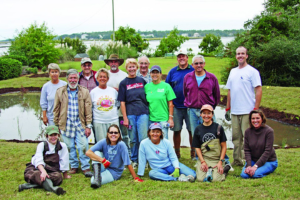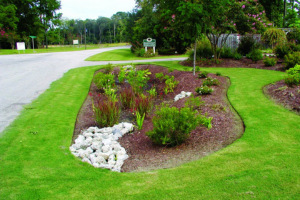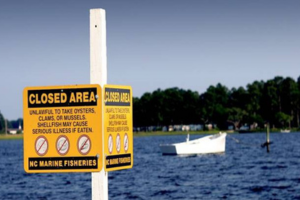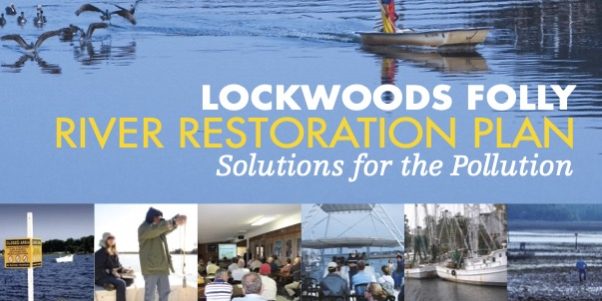The Lockwood Folly watershed in Brunswick County is 150 square miles and includes the island communities of Oak Island and St. James, the traditional fishing village of Varnamtown, and areas of Bolivia, Supply, and parts of Boiling Spring Lakes.
In 2006, partners began to talk about the decline in the quality of local shellfishing waters, mainly due to stormwater pollution. The Coastal Federation teamed up with Brunswick County, state agencies, and the Environmental Protection Agency (EPA) to prepare a study and restoration plan for the river. The plan targets simple solutions to infiltrate rain and reduce polluted runoff.
Lockwoods Folly River Local Watershed Plan Detailed Assessment and Targeting of Management Report



Implementation Projects
Many dedicated partners worked together to install several stormwater retrofit projects in the watershed. Funding for these projects was made possible by the Estuary Restoration Act, North Carolina Attorney General’s Environmental Enhancement Program, Community Conservation Assistance Program, and the EPA Section 319 Grant Program. Below is a sampling of our most recent accomplishments to restore the Lockwood Folly River.
Street Side Swales — 2015
In partnership with the Town of Oak Island, the Federation constructed a series of swales along the right-of-ways at six town-owned streets. The pervious pavement was also installed at one site. The swales store and infiltrate polluted stormwater demonstrating effective options for managing it in a coastal community.
Lakes of Lockwood Subdivision — 2014
Neighbors in the Lakes of Lockwood partnered with the Federation to install 54 rain barrels, eight rain gardens, and native plants throughout their community to reduce the amount of polluted runoff entering the river.
Brunswick Habitat for Humanity — 2014
The Federation partnered with Brunswick County Habitat for Humanity and the Brunswick County Cooperative Extension Service to install rain gardens, native landscaping, and rain barrels on Habitat homes.
Oyster Habitat Restoration — 2014
The Federation constructed 21 oyster reefs in a 3-acre project area in the Lockwood Folly River just below Varnantown. Connaway Marine Construction deployed 12,000 bushels of oyster shells and marl to create the reefs. The reefs provide water quality benefits and essential habitat for many fish and shellfish.
Oak Island Pump Station Project — 2013
The Federation installed a stormwater infiltration trench at the NE 19th St. Pump Station to divert polluted runoff into an infiltration trench.
Arboretum Park Rain Garden — 2013
Oak Island and project partners installed a rain garden at Arboretum Park that addresses erosion, flooding, and polluted runoff problems at the intersection of Middleton Avenue and Island Drive.
Waterway Park Living Shoreline — 2013
The Federation and Oak Island installed a 200-foot-long living shoreline at Waterway Park on the Intracoastal Waterway. Over 400 volunteers, including town officials and staff, made and stacked over 5,000 oyster shell bags to build the reef and then planted marsh grasses landward of the reef to create a beautiful living shoreline.
Sunset Harbor Boat Ramp — 2011
The N.C. Wildlife Resources Commission installed permeable pavement to soak up rain and speed bumps to direct stormwater away from the river at its Sunset Harbor boat ramp.
N.C. Department of Transportation Retrofits — 2011
WithersRavenel, NCDOT, N.C. State University and the Federation partnered to design and install three retrofits that reduce stormwater along N.C. 211. The designs use a specialized high-flow filter soil that increases how the site soaks up water. These retrofit projects are at the north and south sides of the U.S. 17 bridge over Royal Oak Swamp and on the north side of N.C. 211 just east of the intersection with U.S. 17.
Winding River Subdivision — 2010
The Federation, Brunswick County Soil and Water Conservation, and residents of Winding River built rain gardens to prevent stormwater from flowing from their street and boat ramp into the river.
River Run Plantation — 2010
River Run Plantation, the Federation, Brunswick County Soil and Water Conservation, and community volunteers planted two large rain gardens and a native plant buffer to intercept the flow of runoff entering the river.
Brunswick County Government Complex — 2009
The Federation and Brunswick County installed a wetland and rain garden at the Brunswick County Government Complex to reduce polluted stormwater.

